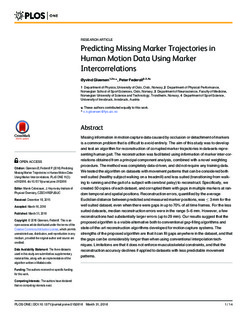| dc.contributor.author | Gløersen, Øyvind Nøstdahl | |
| dc.contributor.author | Federolf, Peter | |
| dc.date.accessioned | 2017-01-17T14:00:13Z | |
| dc.date.available | 2017-01-17T14:00:13Z | |
| dc.date.issued | 2016-03-31 | |
| dc.identifier.citation | PLoS ONE. 2016, 11, 1-14. doi: http://dx.doi.org/10.1371/journal.pone.0152616 | nb_NO |
| dc.identifier.uri | http://hdl.handle.net/11250/2427543 | |
| dc.description.abstract | Missing information in motion capture data caused by occlusion or detachment of markers is a common problem that is difficult to avoid entirely. The aim of this study was to develop and test an algorithm for reconstruction of corrupted marker trajectories in datasets representing human gait. The reconstruction was facilitated using information of marker inter-correlations obtained from a principal component analysis, combined with a novel weighting procedure. The method was completely data-driven, and did not require any training data. We tested the algorithm on datasets with movement patterns that can be considered both well suited (healthy subject walking on a treadmill) and less suited (transitioning from walking to running and the gait of a subject with cerebral palsy) to reconstruct. Specifically, we created 50 copies of each dataset, and corrupted them with gaps in multiple markers at random temporal and spatial positions. Reconstruction errors, quantified by the average Euclidian distance between predicted and measured marker positions, was 3 mm for the well suited dataset, even when there were gaps in up to 70% of all time frames. For the less suited datasets, median reconstruction errors were in the range 5–6 mm. However, a few reconstructions had substantially larger errors (up to 29 mm). Our results suggest that the proposed algorithm is a viable alternative both to conventional gap-filling algorithms and state-of-the-art reconstruction algorithms developed for motion capture systems. The strengths of the proposed algorithm are that it can fill gaps anywhere in the dataset, and that the gaps can be considerably longer than when using conventional interpolation techniques. Limitations are that it does not enforce musculoskeletal constraints, and that the reconstruction accuracy declines if applied to datasets with less predictable movement patterns. | nb_NO |
| dc.language.iso | eng | nb_NO |
| dc.publisher | PLOS | nb_NO |
| dc.subject | walking | |
| dc.subject | algorithms | |
| dc.subject | interpolation | |
| dc.subject | cerebral palsy | |
| dc.subject | human mobility | |
| dc.subject | musculoskeletal system | |
| dc.subject | principal component analysis | |
| dc.subject | covariance | |
| dc.title | Predicting missing marker trajectories in human motion data using marker intercorrelations | nb_NO |
| dc.type | Journal article | nb_NO |
| dc.type | Peer reviewed | nb_NO |
| dc.subject.nsi | VDP::Matematikk og Naturvitenskap: 400::Basale biofag: 470 | nb_NO |
| dc.subject.nsi | VDP::Landbruks- og Fiskerifag: 900::Landbruksfag: 910 | nb_NO |
| dc.source.journal | PLoS ONE | nb_NO |
| dc.identifier.doi | http://dx.doi.org/10.1371/journal.pone.0152616 | |
| dc.description.localcode | Seksjon for fysisk prestasjonsevne /Department of Physical Performance | nb_NO |
